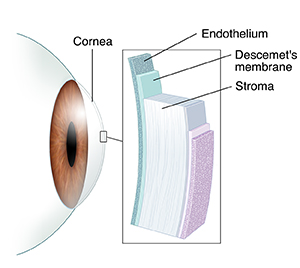Understanding a Corneal Transplant
A corneal transplant is a surgery to replace a cornea that has problems. The cornea is a clear layer on the front of your eye. It helps protect your eye from dirt and germs. It helps control how light enters your eye.
Why a corneal transplant is done
Some health problems can damage a cornea. It can turn cloudy and unclear. Its shape can change. These things can harm your eyesight. In some cases, they can even cause blindness. A corneal transplant removes part or all of the damaged cornea. It's replaced with healthy tissue from a donor. Most people have good eyesight for many years after a corneal transplant.
Some things that can damage a cornea and lead to a corneal transplant are:
-
Bulging of the cornea (keratoconus)
-
Swelling of the cornea (bullous keratopathy)
-
Scarring of the cornea
-
Buildup of substances in the cornea (corneal dystrophy)
-
Inflammation of the cornea (keratitis)
-
Infection of the cornea
-
Injury
-
Complications after cataract surgery
Types of corneal transplant
There are 4 main types of corneal transplant:
-
Penetrating keratoplasty. A surgeon removes the full thickness of the central part of your damaged cornea. It's replaced with a clear cornea from a donor who has died (deceased donor). This donor cornea is sewn onto the eye.
-
Deep anterior lamellar keratoplasty. A surgeon removes only the front part of the cornea. This front part is called the stroma. They replace it with a clear stroma from a deceased donor.
-
Descemet stripping automated endothelial keratoplasty. A surgeon removes only the back part of the cornea. This is called Descemet's membrane. They also remove the endothelium. These are replaced with endothelium and stroma from a deceased donor.
-
Descemet membrane endothelial keratoplasty. A surgeon removes only Descemet's membrane and the endothelium. They are replaced with the same tissue from a deceased donor. This is done without any stroma.
These surgeries may be full thickness or partial thickness. This is a measure of how much tissue is removed and replaced. Your healthcare provider will tell you which type is best for you.

How a corneal transplant is done
Your procedure will be done by an eye surgeon. You will be given eye drops and local or general anesthesia. This is so you don't feel pain. The surgery can be done in several ways. The surgeon may use a very fine thread (stitches) to sew the donor cornea in place. Or an air bubble will be put on your eye to keep the new cornea in place. This is used instead of stitches.
Risks of a corneal transplant
All procedures have risks. Risks of a corneal transplant are:
-
New changes in vision (refractive errors) that need correcting with eyeglasses or contact lenses
-
Infection of the cornea
-
Glaucoma that gets worse
-
Bleeding in the eye
-
Sore on the eye (ulcer or abscess)
-
Blood vessels growing in the cornea caused by the stitches
-
Detachment of the new cornea
-
Clouding of the lens (cataract)
-
Detached retina
-
Eye inflammation
-
Surgery fails to fix your eyesight
A serious risk is rejection of the donor cornea. Your immune system may attack the new cornea. This can cause the transplant to fail. You'll likely need another corneal transplant if this happens. Talk with your eye healthcare provider about the symptoms of rejection. This can help to reduce your risk for rejection. Contact your eye healthcare provider if you do have any of these symptoms. Early treatment may prevent loss of your eyesight.
Your risks may differ based on your age, your health, and the cause of your damaged cornea. Talk with your eye healthcare provider about which risks apply most to you.